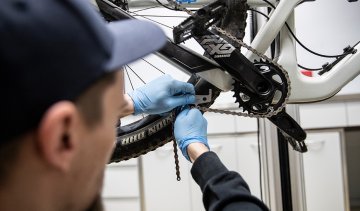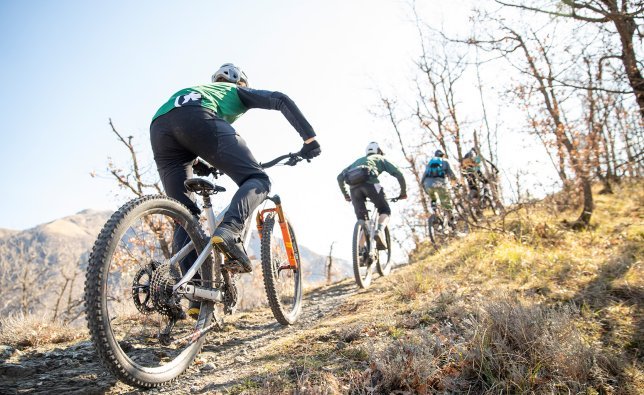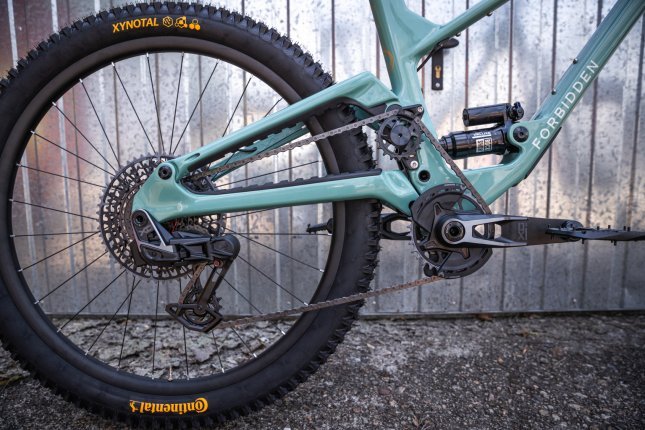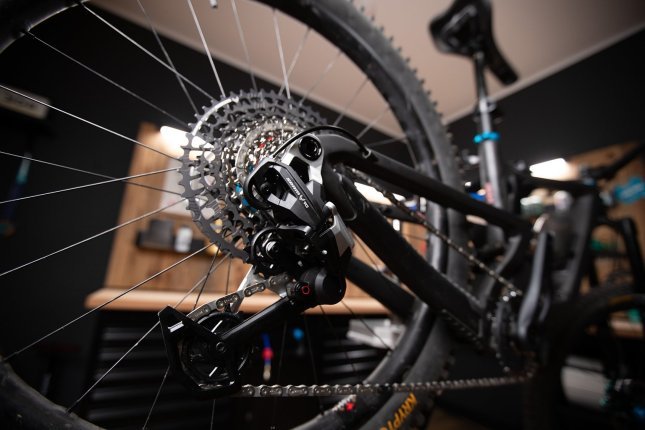
How to: Replacing the MTB Chain
Is the chain on your MTB worn out? Do you want to fit a new one? No worries. We’ll explain how you can replace your chain on your bike.
XTR, XX1, X01, Deore, etc. – The choice of shifters & derailleurs for MTBs is huge. Find out which is the right one for you here.
When it comes to mountain bike drivetrains, there's a lot to consider. All parts must fit the interfaces of your bike and, of course, be compatible with each other. With pre-assembled complete groupsets and upgrade kits from SRAM or Shimano, you're choosing a system that's compatible within itself. To make your decision easier and to know what to look out for, just keep on reading.
In current, high-quality mountain bikes, you'll typically find derailleurs with cassettes that consist of at least 11, more often 12 sprockets, and in most cases, just one chainring without a front derailleur. With the large cassettes (Shimano: 10-51, SRAM: 10-52 teeth) the range of gear ratios of these single drives is sufficient for all situations, even in the mountains. If you often ride in very steep terrain or do bikepacking with a lot of luggage, you can install a smaller chainring to shift the range more towards lighter gears. If you value being able to speed down the mountain with heavy gears, then choose a slightly larger chainring. Although we believe light gears are more important than very heavy ones, since most riders eventually prefer to just coast downhill, but that's for you to decide.
With the omission of the front derailleur in single drives, the drivetrain becomes simpler, less prone to malfunction due to fewer mechanics, and also lighter. Your cockpit is tidier, especially on the left side of the handlebar, where you probably already have a remote for your dropper post. For full suspension bikes, the efficiency of the rear suspension can be improved, as the chain always runs at a similar height, thus reducing negative influences from chain tension. Since the single chainring doesn't need shift ramps for shifting operations, it can be fully focused on reliability. Therefore, on modern single chainrings, you'll find alternating narrower and broader teeth (Narrow-Wide profile), which precisely accommodate the design of the chain and thus guide it much more securely. Since this innovation, chain guides on trail bikes have become almost obsolete, as the chain basically cannot jump off anymore. The manufacturer SRAM offers only single drivetrains for mountain bikes - the front derailleur is a thing of the past. Shimano also primarily offers single drivetrains, but still has front derailleurs as well as cranksets with 2 or 3 chainrings in their lineup. With these traditional groups, the steps between gears on the cassette can be smaller - but that's about the only advantage. In our shop, you can conveniently filter by how many shifting stages you want on your cassette and crank.

A cassette with the largest possible sprockets pays off especially on steep climbs. © bc GmbH
Even though the multi-chainring crank still has its justification, we strongly lean towards the single drive. It has fully established itself, is absolutely practical, and sufficient for all situations. Many modern mountain bike frames no longer have the possibility of mounting a front derailleur – consider this a hint.
In our shop, you'll find complete groupsets and upgrade kits – the difference lies in the scope of delivery. Complete groupsets include rear derailleur, shift lever, cassette, chain, and crankset incl. chainring(s). The so-called upgrade kits, on the other hand, come without the crankset and serve, for example, to upgrade a group from 1x11 to 1x12 without having to replace the crankset, since chainrings for 11-speed chains are also compatible with 12-speed chains. If you just want to replace your worn-out cassette and chain, we also offer wear and tear sets.
Before we move on to the 2 big manufacturers: Whether to ride SRAM or Shimano is for many an absolute matter of faith, and there are good arguments for both manufacturers. There's hardly a "better" or "worse". Ideally, you should try out both manufacturers and their systems before you decide.
The different Shimano groupsets differ significantly in the materials and technologies used, weight, finish, durability, and of course, price. At the top of the hierarchy is the XTR. It stands out due to the use of the highest quality materials and elaborate production processes, making it especially light yet very durable and found on the bikes of many pros. Right below it, you'll find the well-known XT group – it has been around since 1983, making it longer than any other mountain bike group. The SLX group and below, the Deore, are more affordable due to the use of cheaper materials and simpler production processes. However, you don't have to compromise on good shifting quality and gear range, but the more affordable groups are a bit heavier and simpler in design than their more noble siblings.
Below the Deore, there are simpler groups like Alivio, Acera and Co. However, these weren't developed as single-chainring groups and are less intended for the mountain biking scene, which is why we're not covering them here.
The addition of Di2 in the name stands for Shimano's electronic version of the groupset. Unlike SRAM's wireless AXS, its components are fundamentally connected via cables.
SRAM's groupsets vary in the materials used, technologies, finish, weight, and durability. This also affects the price. The XX1 Eagle is at the forefront, closely followed by the X01 Eagle. Originally, the XX1 was more tuned towards XC and marathon, while the X01 was intended to serve trail and enduro riders. As the XX1 group proved to be just as durable and robust despite its lightweight design, it has now been approved for all types of riding and is practical for real-world use. The GX Eagle represents the upper mid-range, comparable to Shimano's XT. NX and SX Eagle are the entry-level groups: a bit heavier, simpler materials and finish, but also durable and precise. Unlike most SRAM groups, these two do not use the special XD freehub body for the cassette but a classic HG freehub. The name suffix "Eagle" is only used for the twelve-speed groups - due to the wide range of the cassette. All Eagle components are fundamentally compatible. AXS stands for electronic shifting controlled wirelessly via radio.
Even though many are skeptical: The top groups XX1 and X01 are noticeably more wear-resistant than the cheaper groups. Especially the chain, cassette, and derailleur, through high-quality materials, coatings, and precise manufacturing processes, are extremely durable, thus the higher price is largely justified.

With Eagle Transmission, SRAM introduced a new generation of mountain bike shifting in 2023, bringing fundamental innovations: The derailleur is no longer mounted on a hanger but to the thru-axle in the dropout of your frame. This automatically aligns it with the cassette, eliminating the need for limit adjustments, and the shifting works very precisely. Moreover, the system is more stable because the mounting - called Full-Mount - encompasses the dropout. If hit, the forces are transferred into the thru-axle and not into the frame. A prerequisite is a frame with UDH dropouts (Universal Derailleur Hanger). Transmission is optimized for precise and smooth shifting under pedal load.
To address compatibility questions, SRAM marks all components that are compatible within the Transmission ecosystem with "T-Type".
Comparable to the well-known SRAM groupsets, Transmission comes in different versions, differing in finish, weight, and price. All are 1x12. The wireless radio-controlled shifting systems are XX SL Eagle Transmission for high-end XC bikes and XX for all other high-end mountain bikes, followed by X0 and GX Eagle Transmission. In 2025, the portfolio was expanded to include two mechanical groups, meaning actuated via Bowden cable: Eagle 90 Transmission (at a similar level as GX) and Eagle 70 Transmission.

The classic shifter is controlled by Bowden cable and hopefully will never die out. The mechanics are proven, reliable, and operate without electricity, which seems to fit the spirit of biking the best.
In the electronic sector, Shimano offers their groups with the addition of Di2 (Digital Integrated Intelligence) which are controlled via cable.
On the other hand, SRAM uses AXS (pronounced: "Access") for their electronic sector, which opts for radio-controlled, wireless components. Gear changes are extremely accurate thanks to the servo motors in the derailleur.
Generally, electronic groupsets feel faster, more precise, and have a more defined haptic feedback, highlighting the technological evolution of bicycles. However, this doesn't mean mechanical shifting is obsolete. It works flawlessly and very reliably, isn't dependent on battery life, although it's very, very long. So, it's a matter of taste whether you go mechanical or electronic. Mechanical shifting systems are cheaper - functionally seen, maybe the "more sensible" choice. But for tech-savvy bikers, an electronic groupset is almost a must.
Learn more about electronic shifting systems in our article "Electronic Shifters & Derailleurs for Road and Mountain Bikes".
To ensure your new groupset fits your bike, you need to consider an important interface: The cassette must match the freehub body on your hub. It was simple in the past: There was the well-known Shimano HG freehub with its characteristic ridges, and every cassette fitted. The smallest sprocket of the cassette had 11 teeth. As single-drive systems became more popular, it was clear that the cassette's range needed to be "pumped up" to compensate for the missing second chainring. The larger sprockets got bigger, of course. Then came the idea to make the smallest sprocket smaller to further increase the range. The problem: The Shimano HG freehub has a certain diameter that does not allow for a sprocket smaller than 11 teeth. So, a smaller freehub was needed. SRAM did pioneering work with the so-called XD freehub, followed later by Shimano with their Micro Spline design. Both are intended to accommodate cassettes with small 10-tooth sprockets.
SRAM started with 10-50T cassettes. Shimano followed with 10-51, and SRAM later countered with 10-52. Thus, ranges were created that could easily compete with a double crankset.
Important: SRAM XD and Shimano Micro Spline are NOT compatible. Only XD-compatible cassettes can be mounted on an XD freehub, and the same applies to Micro Spline.
Consider the compatibility of the cassette with the freehub body when choosing your groupset. © bc GmbH
Important: SRAM XD and Shimano Micro Spline are NOT compatible. XD-compatible cassettes can only be mounted on an XD freehub, same with Micro Spline.
SRAM breaks the mold with one cassette option by offering the NX Eagle as an affordable choice for 12-speed drivetrains with a broad range even without one of the two modern freehub systems: Older or more affordably priced bikes often don't have the option to switch to the new freehubs. That's why SRAM has released an 11-50 tooth cassette that fits classic Shimano HG freehubs.
In this post, we're giving you a comprehensive overview on this topic. Find out what kind of freehub body is installed on your bike and then check the groupset description for the cassette. Our filters will help you in the store if you already know what you need or want. Whether your hub can be converted to a "new" freehub, you can find out from the manufacturer – but we can also provide assistance for the hubs we're familiar with.
If you're about to place an order, make sure to check out the product description and the listed contents of delivery in our store very carefully. In many cases, we've provided links to products that you might need to order separately to complete the setup. For instance, the bottom bracket is almost never included. Outer casings for the cables aren't always provided. For electronic groupsets from Shimano, the cables have to be ordered separately since they need to be the correct length for different frame designs and sizes. Unlike road bike groups, brakes are not included in the package for a mountain bike groupset since they aren't connected to the shift levers.
In our store, you'll find different groups and upgrade kits that at first glance seem very similar. Here, it's important to look closely! The product naming will tell you the manufacturer and group, the number of gears, and whether it's an electronic (Di2 or AXS) or mechanical shifting system. Following that is the size of the chainring if a crankset is included. Before you can add the groupset to your cart, you often still have the choice of the right variant. Here, various parameters might come into play. The measurement 170 or 175 millimeters, for instance, refers to the length of the crank arms. Shimano also gives you the choice between shift levers with a clamp or for mounting on the brake lever (I-Spec). SRAM's shift levers come in Matchmaker version, so they can be combined with SRAM brakes or mounted independently on the handlebar. At the very end of the variant, you usually find the cassette range, i.e., the number of teeth on the smallest and the largest sprocket.
Things get a bit more complicated with groupsets that include a front derailleur. If you like running multiple chainrings, only Shimano remains an option. Here, there are three aspects to consider when choosing the right front derailleur:
For clamp-mounted versions, the outside diameter of the seat tube is important – for thinner seat tubes, there are reducing sleeves. With so many parameters, it's easy to lose track. If you're unsure, always feel free to contact our service.
Not to discredit the front derailleur, but there's a reason why SRAM has phased it out. While multiple chainrings might make sense on a road or touring bike, they're no longer essential on a mountain bike and are excellently replaced by the current single-chainring systems.
2 or 3-speed shifters require the installation of a front derailleur on your MTB. © bc GmbH
Since higher forces are applied to the chain and cassette during shifting on an e-bike drive, there are a few extra features required to ensure performance and durability. For example, SRAM's e-bike-specific shift levers are designed as “Single Click” versions — this means you can only shift one gear in either direction with a press of the shift lever. This protects the components, as the chain and cassette would wear out very quickly if shifted across multiple gears under high chain tension. Both Shimano and SRAM also offer e-bike drivetrains with longer durability. These group sets have fewer gears and are heavier. Shimano's concept is called “Linkglide,” while SRAM has introduced the “EX1” label for the market.
With the SRAM “Transmission”-universe, new group sets are now available that are explicitly designed to withstand shifting under load – making them particularly well-suited for use on e-bikes.
If the complete groupsets in our store don't meet your personal vision for the drivetrain of your custom bike, you can of course put together a custom solution. Within a single manufacturer, you can usually mix and match groups as long as the components are designed for the same number of gears. Here are a few examples:
It's no problem to run a Shimano XTR crankset with an SLX rear derailleur and XT cassette while using Deore shift levers. The prerequisite, however, is that all components have the same number of speeds, i.e., 10, 11, or 12 gears. You cannot mix components with different numbers of speeds – that would set you up for malfunction.
Similarly with SRAM: You can use a GX crankset with an XX1 chain, pair it with an NX shifter and attach a cassette and rear derailleur from the X01 group. But again, the number of speeds must match. It's also worth noting that components within the SRAM Transmission ecosystem are only compatible with each other, not with older SRAM Eagle components.
It's pretty much common sense that pricier components are technically more advanced, often more durable, or both. However, the significance varies across different components. When it comes to durability and shifting quality, it makes sense to go for a really high-quality chain. Since the chain wraps around the cassette, chainring, and derailleur pulleys, causing wear on all these parts, a precisely manufactured chain can reduce overall drivetrain wear. At the same time, the chain itself also wears out more slowly. That's why, at Shimano, we recommend an XT or XTR chain, and at SRAM, we suggest an X01 or XX1 chain, even if the rest of the drivetrain comes from cheaper lines. In the long run, it's often more cost-effective to run an expensive chain on a mid-range drivetrain.
Warning: Never mix Shimano and SRAM components. This will inevitably cause problems – from poor shifting to complete malfunction and total failure. However, some third-party manufacturers do offer compatible cranks and chainrings for both Shimano and SRAM groups, like Hope, Race Face, or e*thirteen. If you're considering this, pay close attention to compatibility with the rest of the group. For absolutely smooth and guaranteed performance, we still recommend staying loyal to one brand throughout.
For that extra dose of customisation on your drivetrain, you can choose from Hope- or e*thirteen-compatible components. © bc GmbH
Along with a set of Allen and possibly Torx keys, you'll need some more specialized tools for assembling a groupset. To change the cassette, you need a cassette remover and a chain whip. To remove your old chain and cut the new one to the right length, you need a chain tool. A chain link pliers is a helpful addition to your toolbox. For optimal adjustment of the derailleur, SRAM includes a very useful adjustment gauge. Also, when it comes to tools, pay attention! Your old chain tool might not be compatible with narrow twelve-speed chains. The same goes for your chain whip or cassette remover.
Now, nothing should stop you from swapping out the groupset or upgrading individual components. But if you still have questions about this complex topic, feel free to reach out to our Service Team anytime.